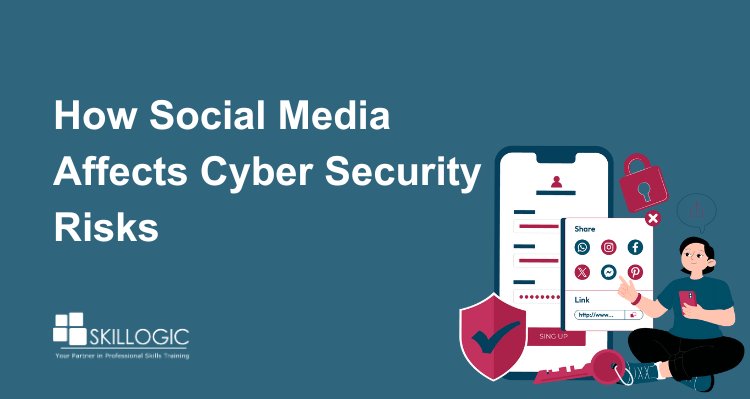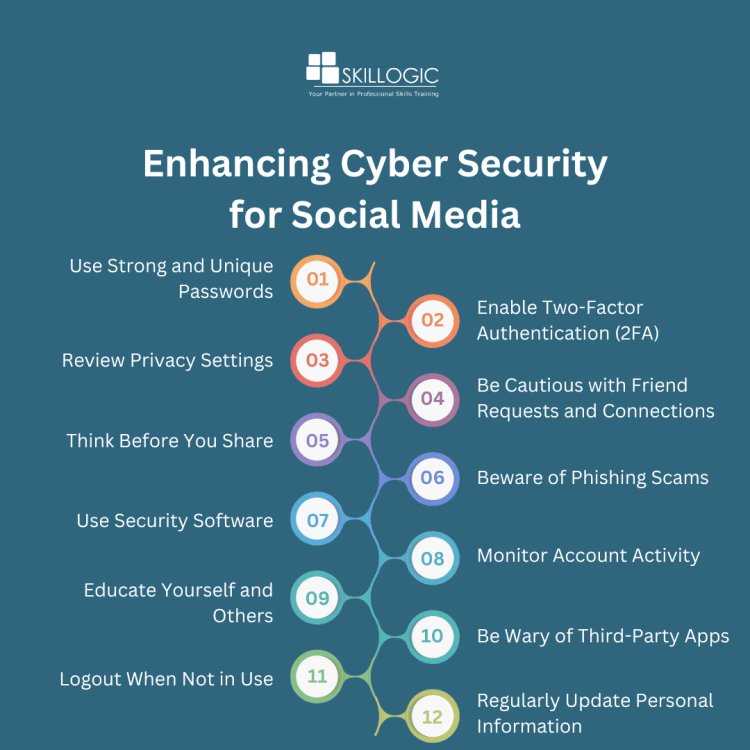How Social Media Affects Cyber Security Risks

In today's digital era, social media has become a vital aspect of everyday life. From connecting with friends to networking for career advancement, platforms like Facebook, LinkedIn, Twitter, and Instagram allow for convenient, widespread communication. However, with these benefits come new risks, especially in the field of Cyber Security . This blog will explore how social media impacts Cyber Security , highlighting best practices for safety and the essential skills for those seeking a career in Cyber Security .
Social media platforms are incredibly useful, but they also come with serious security concerns. With over 4.7 billion users worldwide, social media has created a massive target for cybercriminals. As individuals and companies increasingly use these platforms, they become more vulnerable to data breaches, phishing attacks, and other cyber threats.
For anyone pursuing a Cyber Security certification course or working in the industry, understanding the interaction between social media and Cyber Security is critical. This post delves into the link between social media and Cyber Security threats, offering insights into how you can protect yourself and prepare for a career in Cyber Security.
Understanding Social Media and Cyber Security
Social media and Cyber Security may seem unrelated at first, but they are deeply interconnected. Social media platforms collect vast amounts of user data, including personal information, location, and contact details. This data, if accessed by unauthorized users, can compromise individual privacy and security.
- What Data Social Media Collects: Every post, like, or share provides data that social media platforms can analyze, and unfortunately, cybercriminals can exploit this data too.
- Who is at Risk?: Both individuals and companies are vulnerable, making it essential for anyone working in or studying Cyber Security to understand these risks.
As social media platforms expand, many users share personal details like location, workplace, or birth date—without fully considering the security risks. These details can be exploited by attackers for phishing or identity theft. With this increased exposure, pursuing a career in Cyber Security has become even more essential, as the demand for safeguarding personal information and educating users on online safety continues to rise.
Refer these articles:
- Exploring Cyber Security in the Age of AI
- The Impact of Cyber Security on Your Digital Footprint
- The Human Factor in Cyber Security: Social Engineering Attacks
The Connection Between Social Media and Cyber Security Risks
Social media platforms are prone to Cyber Security risks due to their open, accessible nature. As individuals and organizations create profiles, they expose themselves to several types of cyber risks.
Types of Risks on Social Media
- Phishing Attacks: Social media profiles provide a wealth of information that cybercriminals use to tailor phishing messages, increasing the chances of user interaction.
- Data Breaches: Platforms sometimes suffer data breaches, compromising user information and impacting user trust.
Why Cyber Security is Essential for Social Media Users
Social media introduces vulnerabilities, making it crucial for users and organizations to understand Cyber Security fundamentals. With Cyber Security certification courses available, there is an opportunity for individuals to learn how to protect sensitive data on these platforms.
Pros and Cons of Social Media in Cyber Security
Social media isn’t entirely detrimental to Cyber Security; in fact, it has some advantages. But understanding both sides can help users and Cyber Security professionals navigate the risks more effectively.
Pros of Social Media in Cyber Security
- Awareness and Education: Social media helps spread awareness about Cyber Security issues, making users more vigilant.
- Collaboration among Professionals: Platforms like LinkedIn allow Cyber Security professionals to network, share knowledge, and promote Cyber Security training and educational resources.
Cons of Social Media in Cyber Security
- Increased Exposure: Sharing personal or professional details on social media can make individuals and companies targets for cyberattacks.
- Vulnerability to Phishing and Scams: Users often receive unsolicited messages, links, or friend requests that, if opened, can lead to data compromise.
By enrolling in Cyber Security courses, users can learn to manage the risks associated with social media use and leverage its benefits for their personal and professional lives.
Refer these articles:
- Cyber Security Scope in India
- Cyber Security Course Fee in India
- How to Become a Cyber Security Expert in India

Best Practices for Enhancing Cyber security on Social Media
Enhancing Cyber Security on social media is essential for protecting personal information and maintaining privacy. Here are some best practices to help you safeguard your accounts:
1. Use Strong and Unique Passwords
- Generate complex passwords that incorporate letters, numbers, and special characters.
- Use a different password for each social media account to prevent a single breach from compromising multiple accounts.
- Consider utilizing a password manager to create and securely store your passwords.
2. Enable Two-Factor Authentication (2FA)
- Activate 2FA wherever possible. This adds an extra layer of security by requiring a second form of verification (e.g., a text message code or authentication app).
3. Review Privacy Settings
- Consistently review the privacy settings on your social media accounts to manage who can view your posts and personal information.
- Limit the visibility of your profile to friends only and customize audience settings for posts.
4. Be Cautious with Friend Requests and Connections
- Only accept friend or connection requests from individuals you are familiar with.
- Be wary of profiles with few friends or unusual details, as they may be fake accounts.
5. Think Before You Share
- Do not share personal information, including your address, phone number, or financial details.
- Be mindful of the personal details you share in posts, comments, or messages that could be used for social engineering attacks.
6. Beware of Phishing Scams
- Be cautious of suspicious links in messages or comments, even if they appear to come from friends.
- Always verify the source before clicking on links, especially if the message seems unusual or urgent.
7. Use Security Software
- Install reputable antivirus and anti-malware software on your devices to protect against threats.
- Ensure your software and devices are regularly updated to protect against vulnerabilities.
8. Monitor Account Activity
- Regularly review your account activity for any unauthorized actions, such as strange posts or messages.
- Use the account activity logs (if available) to track login attempts and other significant actions.
9. Educate Yourself and Others
- Keep up to date with the most recent Cyber Security threats and trends.
- Share knowledge with friends and family to help them stay safe on social media.
10. Be Wary of Third-Party Apps
- Minimize the use of third-party applications that request access to your social media accounts.
- Evaluate and remove access to applications that you no longer use or trust.
11. Logout When Not in Use
- Always remember to log out of your social media accounts when using public or shared devices.
- Consider using private browsing modes to prevent saving login information.
12. Regularly Update Personal Information
- Keep your contact information and recovery options up to date in case you need to recover your account.
- By following these best practices, you can significantly enhance your Cyber Security on social media platforms, making it harder for unauthorized users to access your information and accounts.
Refer these articles:
- How to Become a Cyber Security Expert in Hyderabad
- Cyber Security Scope in Chennai
- Cyber Security Course Fees in Bangalore?
Future Trends and Considerations
As we advance into the digital future, the interplay between social media and Cyber Security is evolving. Recognizing these trends is vital for safeguarding online interactions. Here are key considerations that will shape the landscape:
1. Increased Use of Artificial Intelligence (AI)
AI is revolutionizing both Cyber Security and social media management:
- Threat Detection: AI algorithms can analyze data in real-time, identifying unusual patterns indicative of potential cyber threats.
- Content Moderation: Platforms are utilizing AI to filter out malicious content, reducing the risk of phishing attacks.
2. Enhanced Regulatory Frameworks
Stricter regulations are emerging to govern data privacy:
- User Data Protection: Governments are likely to impose regulations similar to the GDPR, focusing on data collection, storage, and sharing.
- Accountability: Companies may face legal consequences for inadequate data protection, driving them to invest in better Cyber Security .
3. Rise of Cyber Security Awareness Programs
Education will be essential in reducing risks.
- Targeted Training: Organizations will implement comprehensive programs to help employees recognize phishing attacks and manage online presence.
- Community Engagement: Social media platforms may offer resources to educate users about the latest Cyber Security threats.
4. Privacy by Design
The future will emphasize integrating privacy into social media development:
- Built-In Privacy Features: New platforms will likely include privacy settings by default, ensuring user protection.
- User-Controlled Data Sharing: Enhanced controls will allow users to determine what information is shared.
5. Integration of Blockchain Technology
Blockchain technology may enhance security and privacy:
- Decentralized Storage: It can reduce data breach risks by offering decentralized data storage solutions.
- Identity Verification: Secure identity verification through blockchain can help combat identity theft.
6. Evolving Cyber Threats
New cyber threats will emerge as technology advances:
- Sophisticated Phishing: Cybercriminals will adopt advanced phishing techniques using AI to create convincing attacks.
- Ransomware Threats: Social media may become a target for ransomware attacks, where criminals extort money by threatening to release sensitive information.
7. Cross-Platform Cyber Security Strategies
The need for cohesive Cyber Security approaches will grow:
- Unified Security Protocols: Organizations will develop integrated protocols to address risks across various platforms.
- Collaborative Efforts: Future collaborations between platforms may lead to shared security frameworks to mitigate threats collectively.
The future of Cyber Security and social media is shaped by rapid technological advancements and evolving threats. By staying proactive, embracing new technologies, and investing in education, users can protect their online presence while reaping the benefits of social media.
At SKILLOGIC Institute, we recognize the critical importance of cyber security tools in today’s digital environment. Our Cyber Security Professional Plus Course is meticulously designed to equip learners with the essential skills needed to effectively utilize various Cyber Security tools and tackle the unique challenges they may encounter. Accredited by respected organizations like IIFIS and NASSCOM FutureSkills, this program offers comprehensive training that includes hands-on projects and specialized practice labs. This practical approach ensures that participants not only become familiar with these tools but also develop a deep understanding of how to implement them to protect systems from potential threats.
With a thriving community of over 100,000 dedicated learners, SKILLOGIC is committed to advancing careers in Cyber Security through high-quality education and practical skills training. Our emphasis on real-world applications and industry-recognized certifications positions us as a top choice for professionals aiming to excel in the ever-evolving field of Cyber Security. Join us to acquire the knowledge and expertise needed to effectively navigate the landscape of essential Cyber Security tools.

0
449